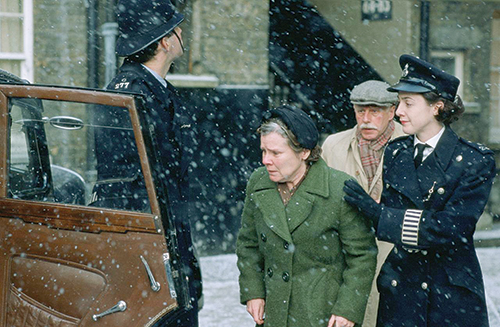
Roe v. Wade is 40 years old and the United States still struggles to talk rationally about women’s reproductive rights.
In one of the most prominent (and dubious) recent attempts, former Missouri legislator Todd Akin (in)famously stated that, in cases of “legitimate rape, the female body has ways to try to shut the whole thing down” (the “whole thing” here being pregnancy)—and then stuck around long enough to garner 39 percent of the vote in his 2012 U.S. Senate bid.
When it comes to abortion, assumptions are made, aspersions are cast, lines are drawn. But rarely do we, as participants in this often-vitriolic campaign, stand back to ruminate on the moral burden placed on the shoulders of those who carry out these operations—who “help these women out,” as the titular character of Mike Leigh’s 2004 film, Vera Drake, would put it.
The Women’s Resource Center’s Reproductive Justice Action Team is screening Vera Drake tomorrow on campus. The action team works “to support the rights of people to make their own decisions about their own reproductive and sexual health,” according to its website, and the group has certainly selected a pertinent and provoking film.
Set in London in 1950, Vera Drake tells the story of a family doing its best to survive—and hopefully thrive—in post-war England. Unbeknownst to the rest of the Drakes, the matriarch, Vera, has been “helping women out” by providing them with illegal, in-home abortions for years.
Vera (played by the remarkable Imelda Staunton) is “as good as gold,” a “diamond,” and has “a heart of gold,” according to various characters in Leigh’s film. And, as the story gets going, we see they’re right. The short, matter-of-fact early scenes—Vera fluffing a dying man’s pillow, Vera fixing a hungry neighbor something to eat, Vera dusting the piano—provide a distinct picture of our heroine in her element: hard at work.
As these early scenes of selfless domesticity roll on, Staunton reveals Vera bit by bit, giving us a glimpse of the depth of her character and the true, deep goodness of her heart.
Leigh (Another Year, Happy-Go-Lucky) juxtaposes Vera’s days as a domestic worker with scenes of her immediate family making their daily bread.
Her husband, Stan, works side by side with his brother Frank at an auto body shop in town, while the couple’s grown children contribute to the household, daughter Ethel in a menial assembly line job and son Sid as a tailor.
The cumulative effect of these scenes reveals itself when, after the camera has peered into everyone’s workday, Leigh turns the lens on Vera, who has just been let into a house by a meek, terrified teenage girl.
Vera attempts to set the frazzled girl’s mind at ease. “First thing we have to do is put the kettle on,” Vera tells her sweetly. (Mrs. Drake has a near-religious belief in the restorative effects of a good cup of tea.)
Vera instructs the teen to grab a towel, take her “knickers off” and “pop [her] bottom on the bed” while Vera fetches her some tea. Vera tries to relax the girl, telling her “I’m here to help, and that’s what I’m going to do.”
As the girl tries to get comfortable, Vera inserts a Higginson syringe “down there” (as she refers to the female anatomy) and begins hand-pumping a water solution inside the woman, telling her that “when you feel full, we’ll stop.”
Vera Drake
Wednesday, April 3, 6 p.m.
Women’s Resource Center Lounge
Free and open to the public
These gentle reassurances of her desire to help typify Vera’s view of the illegal act she commits day after day. Be it an exhausted mother of seven with a deadbeat husband, an unfaithful wife or a poor Caribbean immigrant, Vera thinks every woman deserves her help—that every woman deserves a measure of control.
Leigh’s understated direction carries the film along steadily, though as seasoned filmgoers we’re smart enough to know that Mrs. Drake will not simply continue performing illegal abortions apace until the credits roll—the end, happily ever after.
Vera’s reckoning comes after complications arise from one of her procedures, putting a teenage girl in the hospital on the brink of death. The police eventually trace the source of the girl’s hospitalization—the “procured miscarriage”—back to Vera and come knocking.
As her dark secrets come to light and her family deals with the fallout, Leigh uses these fraught moments to limn his characters,’ well, characters.
Vera’s son Sid can barely contain his contempt for what he calls his mother’s “dirty” work, while the stoic Stan (in a tremendous performance by Phil Davis) forgives her, telling Sid that “God knows she’s going to get punished enough for what she’s done.”
The revelation of Vera’s crimes cedes some of the spotlight to the supporting cast, and Davis and Daniel Mays’ Sid take the opportunity and deliver, deepening our understanding of them.
But Vera’s comeuppance also exposes the two-dimensionality of some of the supporting cast and the film’s uneven story. Ethel, for example, is given ample screen time and a couple big plot points but by film’s end is still nothing more than a cipher, a prop in the back of the shot.
And as the arc of Leigh’s film becomes clear, it’s hard not to wonder what happened to all those other potential story lines that were introduced and then abandoned.
Though the story hints early on that it may directly tackle the upstairs/downstairs dynamic and its attendant social class issues, race and other meaty topics, it discards many of these. Leigh leaves an awful lot of loose ends.
Fortunately, Staunton’s tour-de-force performance (she was nominated for a Best Actress Oscar) remedies Vera Drake’s inconsistencies, and it is Vera, always helpful, doting and kind, who gives this film its heart and soul—forcing us to ask questions and confront issues that are just as relevant 60 years later.

